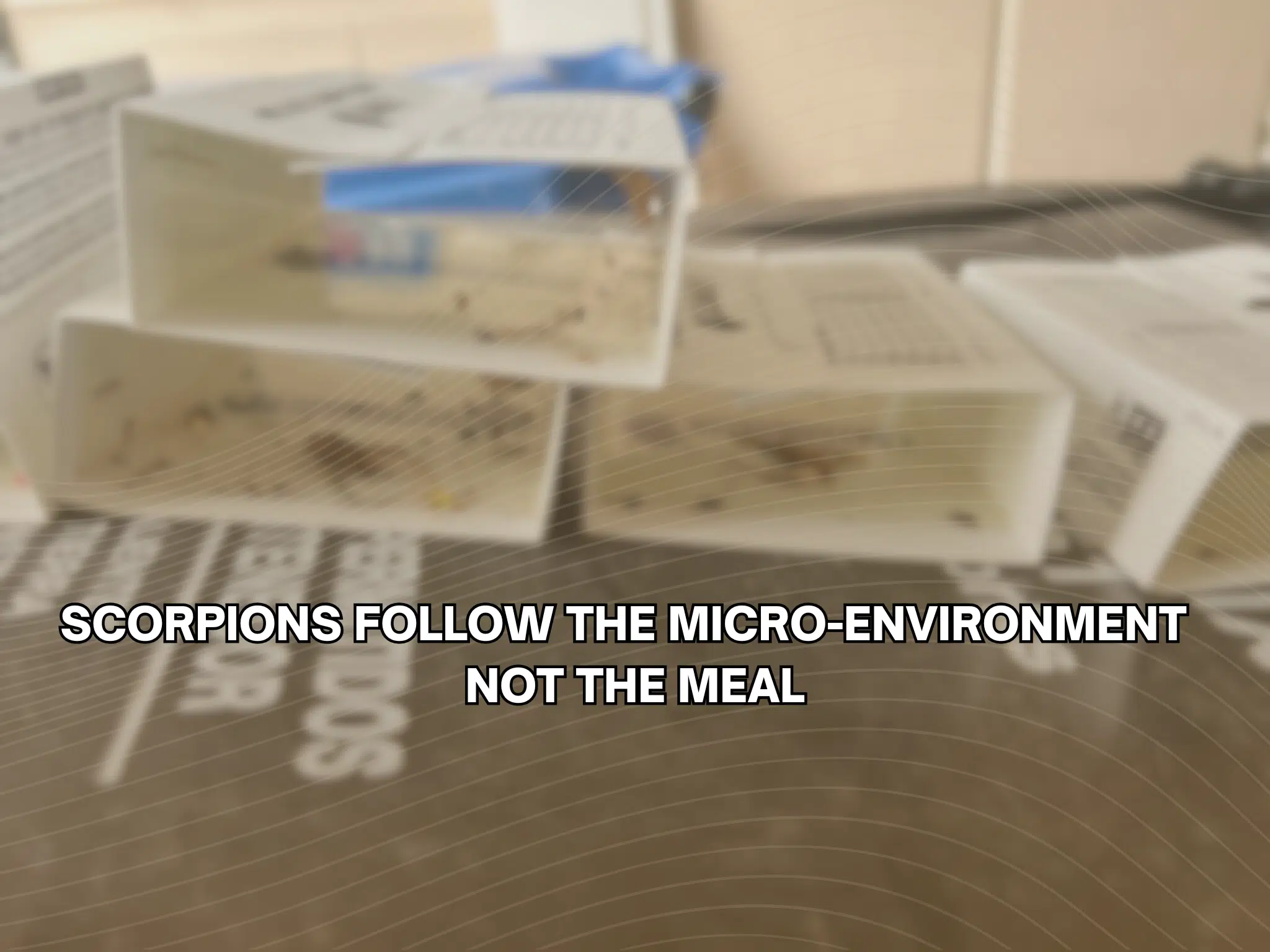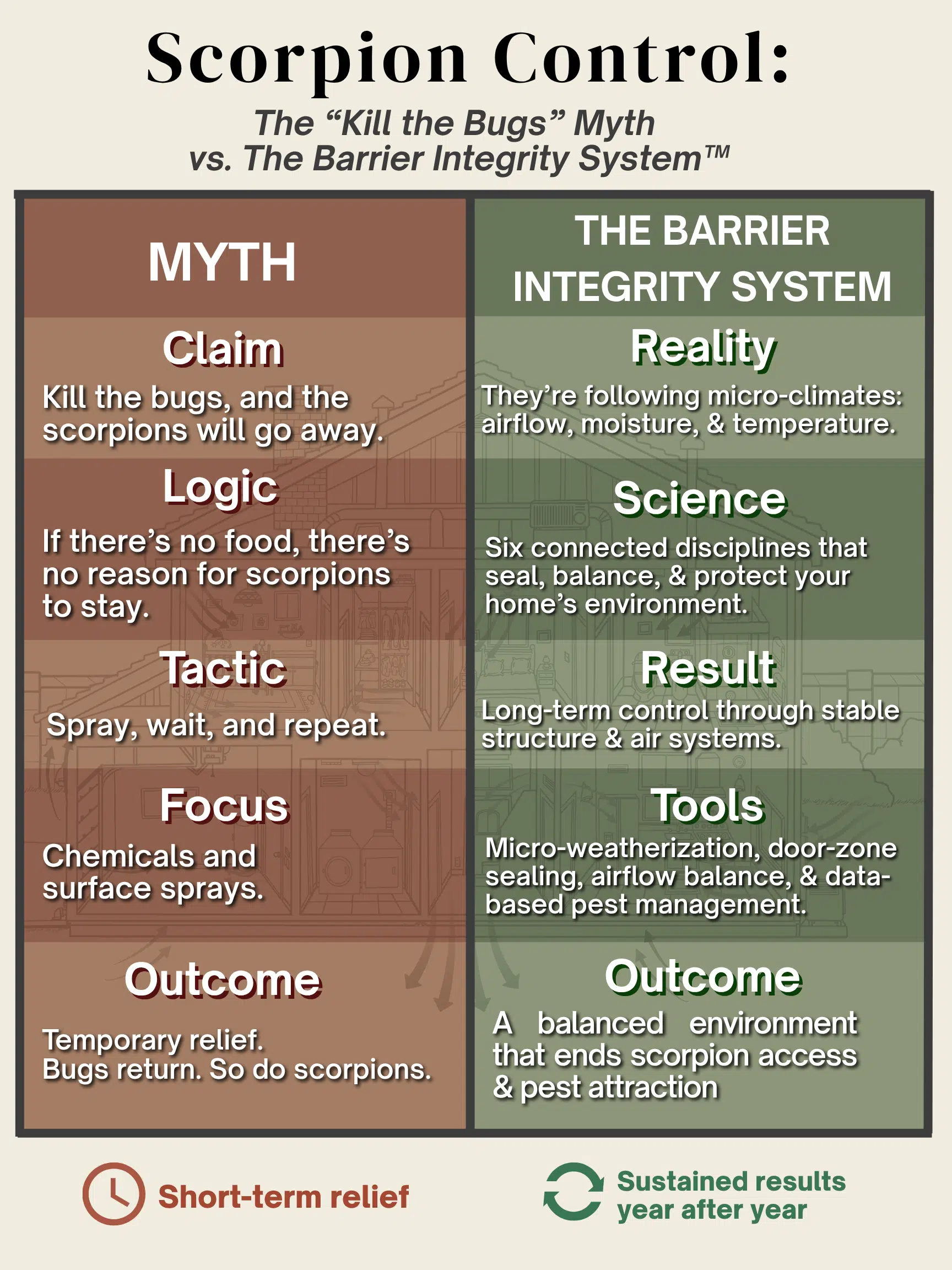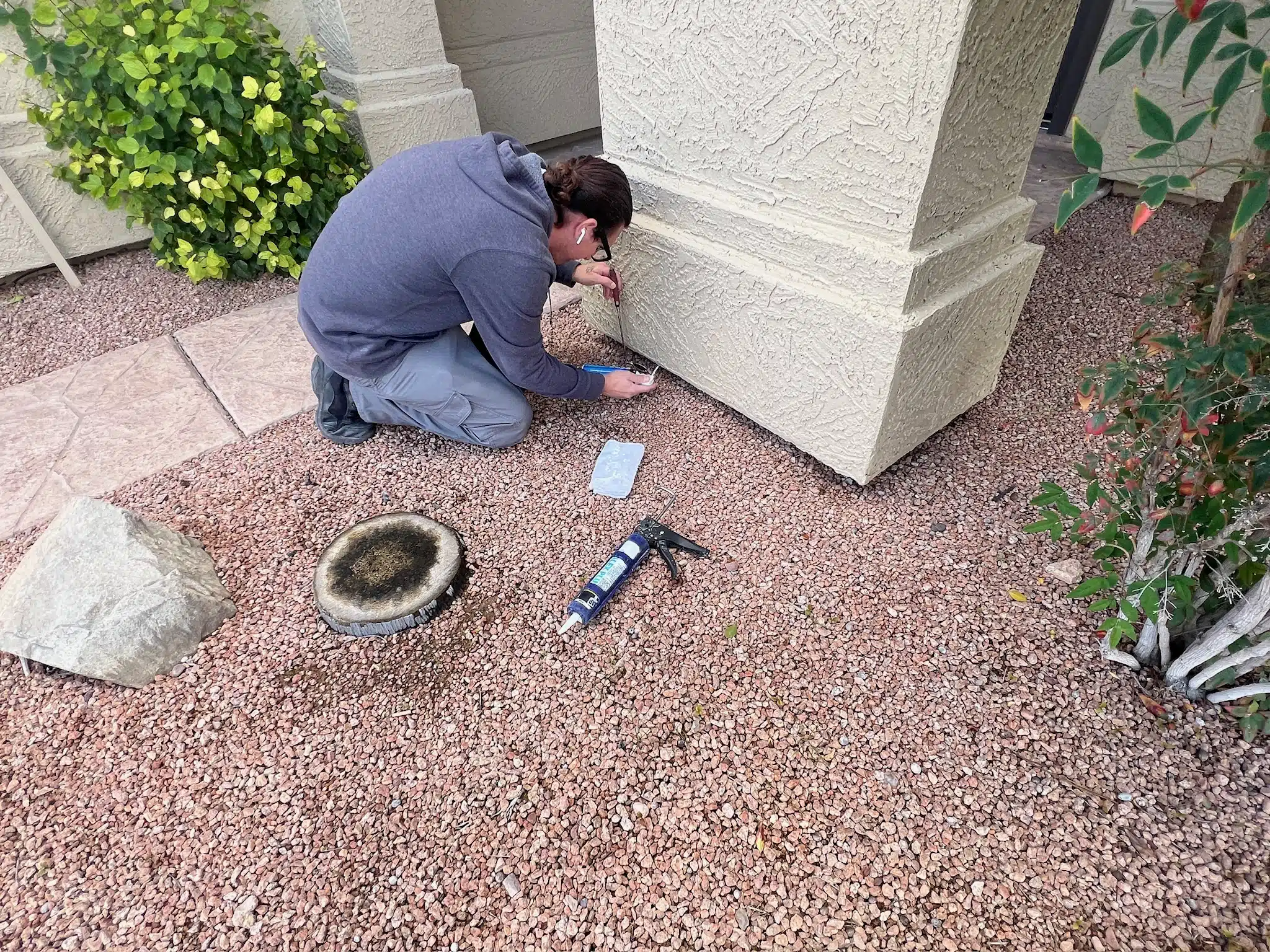Scorpion Control: Kill The “Food-Source” Myth
Why Scorpion Control Requires More Than Killing Bugs
For decades, pest control companies have repeated the same line:
“If we kill the bugs, the scorpions will go away.”
It sounds logical, but it isn’t true. The Arizona Bark Scorpion (Centruroides sculpturatus) doesn’t follow food the way ants, spiders, or rodents do. They follow micro-climates, specific zones of moisture, airflow, temperature, and shelter where life, including their prey, happens to thrive.
When you eliminate insects, you reduce one variable, but the environmental drivers remain. And those environmental drivers are what attract scorpions most.
The Myth At The Root Of Failed Scorpion Control
The “kill the bugs” approach was born out of limitation, not science.
Most pest control technicians are trained to control insects, creatures with entirely different biology, sensory systems, and vulnerabilities than scorpions.
Scorpions are arachnids, but they’re not spiders. Spiders spin webs, rely on fangs, and respond to light, vibration, and chemical treatments differently. Scorpions, on the other hand:
- Use pectines, comb-like sensory organs, to detect minute vibrations, air pressure, and ground chemistry.
- Don’t build webs or traps, they’re ambush predators that wait for prey to come near.
- Can go months without food and even cannibalize other scorpions when necessary.
- Thrive in environments with stable moisture, temperature, and airflow, often identical to those that attract insects.
So while insects may die after a spray, the conditions that drew both them and the scorpions remain.
That’s why homeowners so often say:
“We hardly see any bugs, but we still have scorpions.”
Why Pest Companies Keep Pushing the Food-Source Theory
It’s not dishonesty, it’s a blind spot.
When technicians don’t know how to control scorpions directly, they revert to what they do know: insect reduction.
The “kill the bugs” narrative gives both the technician and homeowner something simple to visualize. Unfortunately, it’s biologically incomplete and operationally ineffective.
Scorpions don’t starve out when food is scarce; they conserve energy, wait, or move to the next cool, moist crevice, often your home’s perimeter, wall voids, or door zones.
What Scorpions Actually Follow
Scorpions follow environmental gradients, airflow, moisture, and temperature differences that mimic desert rock fissures.
Their typical pattern:
- Nighttime: Hunt or wait near light-drawn insects (passive opportunism, not active pursuit).
- Daytime: Retreat into cool, humid, protected spaces like expansion joints, block walls, wall voids, under baseplates, or beneath landscaping.
- Inside homes: Slip through air-exchange gaps, weep screeds, door thresholds, electrical or plumbing penetrations, attic vents, and garage transitions, because those areas feel like natural refuge zones.
So they aren’t “chasing food.”
They’re following the micro-environment that sustains life itself.
The Healthcare Analogy: Scorpion Control As Coordinated Care
Think of your home like the human body.
If you see five different specialists, but no one oversees how those treatments interact, you end up with fractured care, each symptom treated separately, the system ignored.
That’s exactly what happens when pest control, sealing contractors, and landscapers work independently. One sprays for insects. One caulks visible gaps. One maintains irrigation. No one integrates it all.
Effective scorpion control demands a multi-disciplinary approach, building science, pest biology, environmental chemistry, and homeowner behavior, guided by one system that understands how everything connects.
The Building-Science Reality
Homes breathe. Air moves through hundreds of micro-channels, foundation joints, wall seams, attic vents, plumbing gaps, creating temperature and moisture gradients that scorpions can detect and navigate.
If your sealing isn’t managed at the micro-weatherization level, balancing air pressure, moisture, and structural expansion, the scorpion pathways remain.
That’s why homes freshly caulked by contractors or “scorpion sealing” companies still experience infestations. They addressed visibility, not physics.
The Effective Standard: The Barrier Integrity System™
At Seal Out Scorpions, we’ve set the effective standard since 1999 by uniting six interlocking disciplines that eliminate the conditions scorpions rely on:
- Neighborhood Environment: Assess local pressure from terrain, irrigation, and lighting.
- Structure & Landscape: Seal foundation and wall gaps; separate plants and soil from the home.
- Micro-Weatherization: Control airflow, humidity, and install physical barriers that block scorpion pathways.
- Door-Zone Protection: Reinforce thresholds, sweeps, and garage transitions to close entry points.
- Integrated Pest Management (IPM): Create environmental balance using data-driven, minimal treatments.
- Resident Understanding & Strategy: Teach homeowners how to maintain and strengthen their barrier year-round.
Together, these six pillars form a complete, measurable system that stabilizes your environment, eliminates scorpion access, and delivers lasting results.
The Outcome
When all six pillars work together, your home becomes a self-regulating defense system. Airflows are stabilized, micro-climates are neutralized, and scorpions lose their navigational advantage.
The Barrier Integrity System™ isn’t a new idea, it’s the effective standard that has defined Seal Out Scorpions since 1999.
It’s why our clients experience consistent, measurable results year after year, while others keep chasing temporary fixes.
In Closing: The Real Way to Stop Scorpions
Killing food sources may help, but it will never solve the root problem.
Scorpions don’t leave because their food dies.
They leave because the environment that sustains them no longer exists.
That’s what true Barrier Integrity accomplishes:
- It removes airflow cues they follow.
- It eliminates moisture corridors.
- It disrupts their micro-climate comfort zones.
- It builds a home that tells scorpions: “You don’t belong here.”
If you’re ready to move beyond the food-source myth and take control of your home, request a Barrier Integrity Audit today.
We’ll identify your vulnerabilities, provide a measurable score, and design a lasting plan for true scorpion defense, proven, effective, and backed by 25 years of experience.
About Seal Out Scorpions®
Seal Out Scorpions is led by Georgia A. Clubb, Advanced Scorpion Specialist, together with William L. Clubb and Michael C. Golleher — Certified Building Analysts and Envelope Professionals through the Building Performance Institute, with additional Building Science Certificates and studies in Urban & Industrial IPM through Purdue University. Their team includes licensed pest management and sealing specialists who pioneered Building Performance Sealing to solve scorpion problems at the structural level.

















